#IC 5332
Text
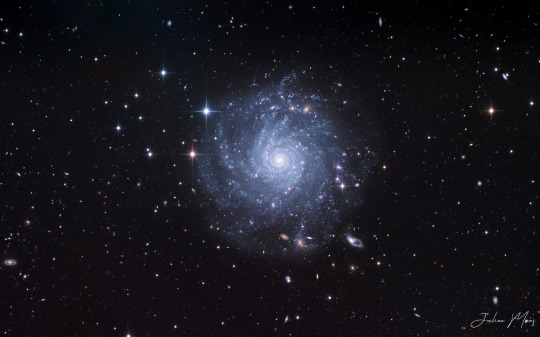
IC 5332 // Jochen Maes
180 notes
·
View notes
Text

Weakly Barred Spiral
121 notes
·
View notes
Text
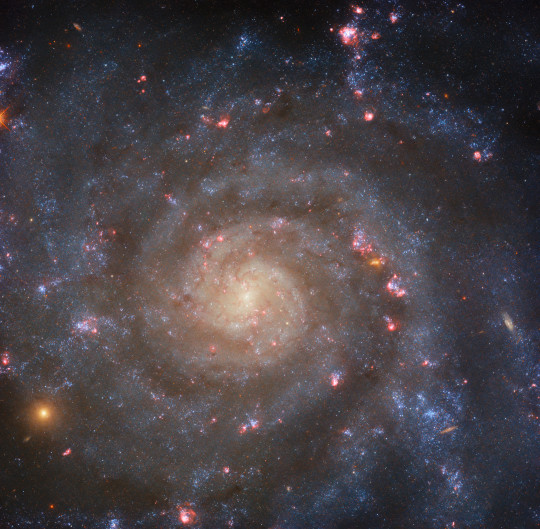
Hubble Captures a Galaxy Face-On
This glittering image from the NASA/ESA Hubble Space Telescope shows the spiral galaxy IC 5332. The galaxy lies about 30 million light-years away in the constellation Sculptor and has an almost face-on orientation to Earth. To understand the term ‘face-on,’ it is helpful to visualize a spiral galaxy as an extremely large disk. If the galaxy’s orientation makes it appear circular and disk-shaped from our perspective on Earth, then we say that it is ‘face-on.’ In contrast, if the galaxy’s orientation is such that it appears squashed and oval-shaped, then we say that it is ‘edge-on.’ The key thing is that the same galaxy would look extremely different from our perspective depending on whether it was face-on or edge-on as seen from Earth.
0 notes
Photo

Hubble Space Telescope
The winding spiral structure of the galaxy IC 5332 is portrayed in amazing detail by this image from the NASA/ESA Hubble Space Telescope. The clarity of Hubble’s Wide Field Camera 3 (WFC3) separates the arms of the galaxy from dark patches of dust in between, which block out the ultraviolet and visible light Hubble is sensitive to. Younger and older stars can be differentiated by their colours, showing how they are distributed throughout the galaxy. Meanwhile, Webb’s MIRI image provides a very different view, instead highlighting the patterns of gas spread throughout the galaxy.
#hubble space telescope#galaxy IC 5332#nasa#nasa picture of the day#space#astronomy#beauty#beautiful#pretty
20 notes
·
View notes
Photo


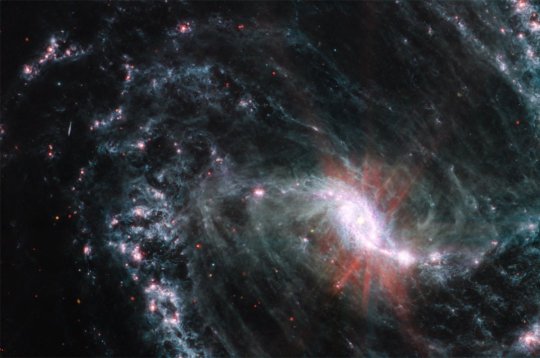
NASA’s Webb Reveals Intricate Networks of Gas, Dust in Nearby Galaxies Peering through obscuring clouds of dust, the MIRI instrument has revealed networks of giant cavities and blown-out bubbles in the gaseous arms of distant galaxies. Researchers using NASA’s James Webb Space Telescope are getting their first look at star formation, gas, and dust in nearby galaxies with unprecedented resolution at infrared wavelengths. The data has enabled an initial collection of 21 research papers which provide new insight into how some of the smallest-scale processes in our universe – the beginnings of star formation – impact the evolution of the largest objects in our cosmos: galaxies. The largest survey of nearby galaxies in Webb’s first year of science operations is being carried out by the Physics at High Angular resolution in Nearby Galaxies (PHANGS) collaboration, involving more than 100 researchers from around the globe. The Webb observations are led by Janice Lee, Gemini Observatory chief scientist at the National Science Foundation’s NOIRLab and affiliate astronomer at the University of Arizona in Tucson. The team is studying a diverse sample of 19 spiral galaxies, and in Webb’s first few months of science operations, observations of five of those targets – M74, NGC 7496, IC 5332, NGC 1365, and NGC 1433 – have taken place. The results are already astounding astronomers. “The clarity with which we are seeing the fine structure certainly caught us by surprise,” said team member David Thilker of Johns Hopkins University in Baltimore, Maryland. “We are directly seeing how the energy from the formation of young stars affects the gas around them, and it’s just remarkable,” said team member Erik Rosolowsky of the University of Alberta, Canada. The images from Webb’s Mid-Infrared Instrument (MIRI) reveal the presence of a network of highly structured features within these galaxies – glowing cavities of dust and huge cavernous bubbles of gas that line the spiral arms. In some regions of the nearby galaxies observed, this web of features appears built from both individual and overlapping shells and bubbles where young stars are releasing energy. “Areas which are completely dark in Hubble imaging light up in exquisite detail in these new infrared images, allowing us to study how the dust in the interstellar medium has absorbed the light from forming stars and emitted it back out in the infrared, illuminating an intricate network of gas and dust,” said team member Karin Sandstrom of the University of California, San Diego. The high-resolution imaging needed to study these structures has long evaded astronomers – until Webb came into the picture. “The PHANGS team has spent years observing these galaxies at optical, radio, and ultraviolent wavelengths using NASA’s Hubble Space Telescope, the Atacama Large Millimeter/Submillimeter Array, and the Very Large Telescope’s Multi Unit Spectroscopic Explorer,” added team member Adam Leroy of the Ohio State University. “But the earliest stages of a star’s life cycle have remained out of view because the process is enshrouded within gas and dust clouds.” Webb’s powerful infrared capabilities can pierce through the dust to connect the missing puzzle pieces. For example, specific wavelengths observable by MIRI (7.7 and 11.3 microns) and Webb’s Near-Infrared Camera (3.3 microns) are sensitive to emission from polycyclic aromatic hydrocarbons, which play a critical role in the formation of stars and planets. These molecules were detected by Webb in the first observations by the PHANGS program. Studying these interactions at the finest scale can help provide insights into the larger picture of how galaxies have evolved over time. “Because these observations are taken as part of what's called a treasury program, they are available to the public as they are observed and received on Earth,” said Eva Schinnerer of the Max Planck Institute for Astronomy in Heidelberg, Germany, and leader of the PHANGS collaboration. The PHANGS team will work to create and release data sets that align Webb’s data to each of the complementary data sets obtained previously from the other observatories, to help accelerate discovery by the broader astronomical community. “Thanks to the telescope’s resolution, for the first time we can conduct a complete census of star formation, and take inventories of the interstellar medium bubble structures in nearby galaxies beyond the Local Group,” Lee said. “That census will help us understand how star formation and its feedback imprint themselves on the interstellar medium, then give rise to the next generation of stars, or how it actually impedes the next generation of stars from being formed.” The research by the PHANGS team is being conducted as part of General Observer program 2107. The team’s initial findings, composed of 21 individual studies, were recently published in a special focus issue of The Astrophysical Journal Letters. More About the Mission The James Webb Space Telescope is the world’s premier space science observatory. Webb will solve mysteries in our solar system, look beyond to distant worlds around other stars, and probe the mysterious structures and origins of our universe and our place in it. Webb is an international program led by NASA with its partners, ESA (European Space Agency), and CSA (Canadian Space Agency). MIRI was developed through a 50-50 partnership between NASA and ESA. NASA’s Jet Propulsion Laboratory led the U.S. efforts for MIRI, and a multinational consortium of European astronomical institutes contributes for ESA. George Rieke with the University of Arizona is the MIRI science team lead. Gillian Wright is the MIRI European principal investigator. Laszlo Tamas with UK ATC manages the European Consortium. The MIRI cryocooler development was led and managed by JPL, in collaboration with Northrop Grumman in Redondo Beach, California, and NASA’s Goddard Space Flight Center in Greenbelt, Maryland. TOP IMAGE....The Mid-Infrared Instrument (MIRI) on NASA’s James Webb Space Telescope took this image of NGC 1433, a barred spiral galaxy with a particularly bright core surrounded by double star-forming rings. The observations reveal cavernous bubbles of gas where forming stars have released energy. Credit: NASA, ESA, CSA, and J. Lee (NOIRLab). Image processing: A. Pagan (STScI) CENTRE IMAGHE....The spiral arms of galaxy NGC 7496 are filled with cavernous bubbles and shells overlapping one another in this image from MIRI. These filaments and hollow cavities are evidence of young stars releasing energy and, in some cases, blowing out the gas and dust of the interstellar medium surrounding them. Credit: NASA, ESA, CSA, and J. Lee (NOIRLab). Image processing: A. Pagan (STScI) LOWER IMAGE....In this MIRI image of galaxy NGC 1365, clumps of dust and gas in the interstellar medium have absorbed the light from forming stars and emitted it back out as infrared light. This illuminates an intricate network of cavernous bubbles and filamentary shells. Credit: NASA, ESA, CSA, and J. Lee (NOIRLab). Image processing: A. Pagan (STScI)
91 notes
·
View notes
Photo
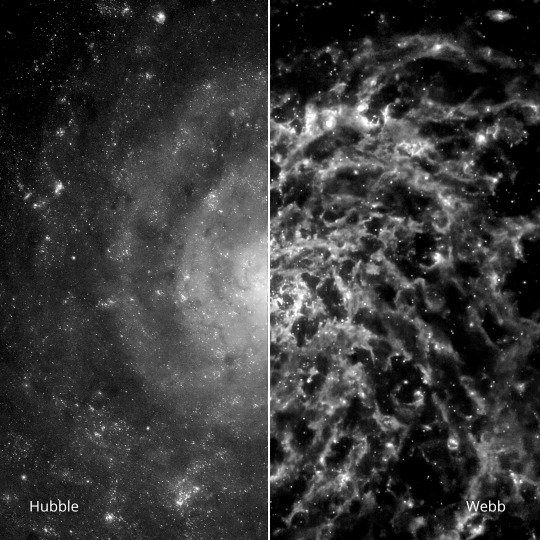
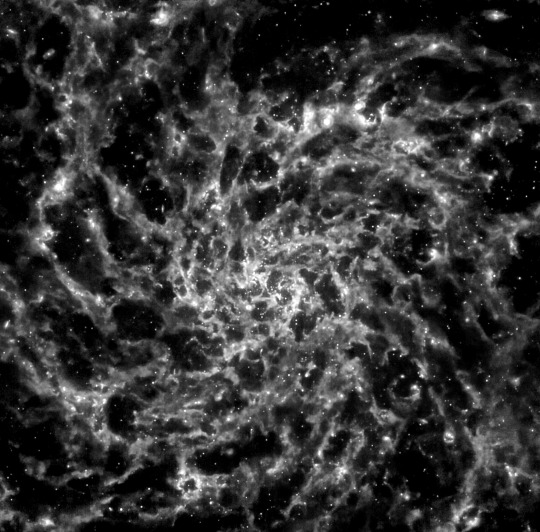
Side-by-side comparison of galaxy IC 5332 as seen by the Hubble and Webb telescopes. It pieces together the left half of Hubble’s image and the right half of Webb’s image, with a white line separating the two. Each side is labeled. Hubble’s half shows glowing blue stars making up the spiral arms of the galaxy, with dark brown regions of dust in between the arms. Webb’s half resembles gray cobwebs, which are patterns of gas, in the shape of a spiral. Tiny blue dots are scattered throughout, as well as some larger, sparser red dots. The galactic core glows pale yellow on Hubble’s side and blue on Webb’s side.
Image of galaxy IC 5332 as taken by the Webb telescope’s MIRI instrument, resembling gray cobwebs in the shape of a spiral. These “cobwebs” are patterns of gas spread throughout the galaxy. The core of the galaxy glows a dark blue. Stars, seen as tiny blue dots, are scattered throughout the image. There are also sparser, larger red dots spread out among the spiral arms. The background of the image is dark.
Credit: ESA/Webb, NASA & CSA, J. Lee and the PHANGS-JWST and PHANGS-HST Teams
#space#spaceedit#astronomy#astronomyedit#spacesource#galaxy#nasa#james webb space telescope#hubble space telescope#mine*#creatorlin#usertuni#userhualians#userjamie
125 notes
·
View notes
Photo
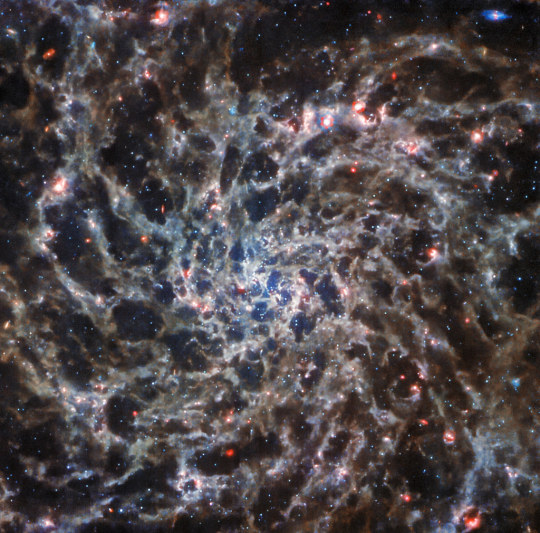
Webb Reveals IC 5332 by James Webb Space Telescope Space, but make it goth! ️ If this new image from Webb’s mid-infrared instrument (MIRI) looks dark and moody, that's because things look different in mid-infrared light than in visible, ultraviolet, or near-infrared light — the wavelengths you may be more used to seeing from Hubble, Webb and other space telescopes. These are the "bones” of galaxy IC 5332, usually hidden by dust. In mid-infrared light, Webb is able to peer through that dust and see the patterns of gas spread throughout the galaxy. Webb only has one instrument that’s able to see in mid-infrared, making MIRI cool in more ways than one. MIRI’s cryocooler, a special refrigerator, helps keep it just a few degrees shy of absolute zero, the lowest possible temperature! Learn more: esawebb.org/images/comparisons/potm2209a/ [Image description: Image of galaxy IC 5332 as taken by the Webb telescope’s MIRI instrument, resembling gray cobwebs in the shape of a spiral. These “cobwebs” are patterns of gas spread throughout the galaxy. The core of the galaxy glows a dark blue. Stars, seen as tiny blue dots, are scattered throughout the image. There are also sparser, larger red dots spread out among the spiral arms. The background of the image is dark.] Credit: ESA/Webb, NASA & CSA, J. Lee and the PHANGS-JWST and PHANGS-HST Teams https://flic.kr/p/2nPoUQn
88 notes
·
View notes
Text
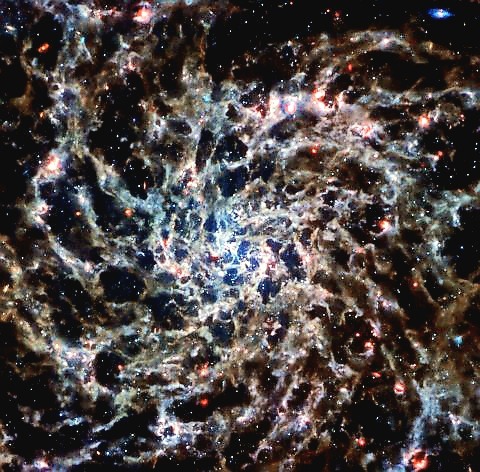
Spiral Galaxy IC 5332
Captured by the James Web Telescope
40 notes
·
View notes
Text
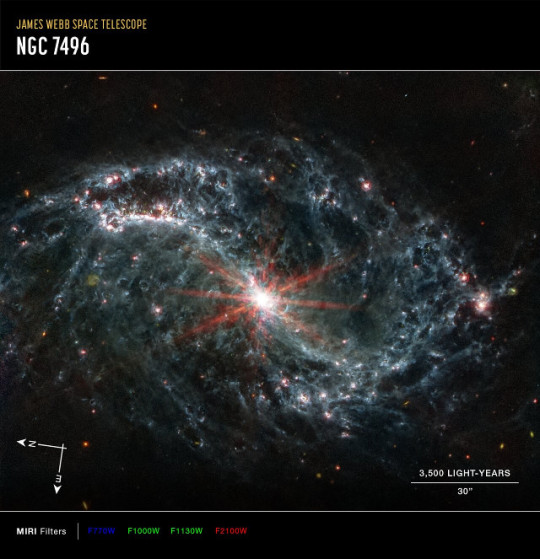
A special issue of "The Astrophysical Journal Letters" contains a series of articles reporting the first results of the PHANGS–JWST survey. More than one hundred researchers from the Physics at High Angular resolution in Nearby Galaxies (PHANGS) Collaboration used the James Webb Space Telescope to examine the galaxies M74, NGC 7496, IC 5332, NGC 1365, and NGC 1433. In particular, the Mid-Infrared Instrument (MIRI) made it possible to observe structures within those galaxies in previously unseen detail. The information gathered is valuable for reconstructing star formation processes and the influence they have on the gas surrounding protostars and newborn stars.
4 notes
·
View notes
Text
James Webb Space Telescope Sees Features Astronomers Have Yet to Explain [ Galaxy ]
James Webb Space Telescope Sees Features Astronomers Have Yet to Explain [Highlights]
The James Webb Space Telescope has captured a stunning image of a chaotic
region of space near the center of our galaxy—around 25,000 light…
Webb Reveals Complex Galactic Structures: This image unveils IC 5332, a
spiral galaxy, showcasing its symmetrical spiral arms and intricate…
The James Webb Space Telescope…
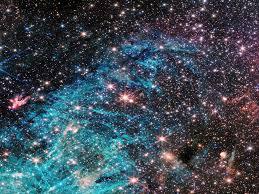
View On WordPress
0 notes
Link
Hubble captures spiral galaxy IC 5332 face-on – The Lifestyle Insider
0 notes
Photo
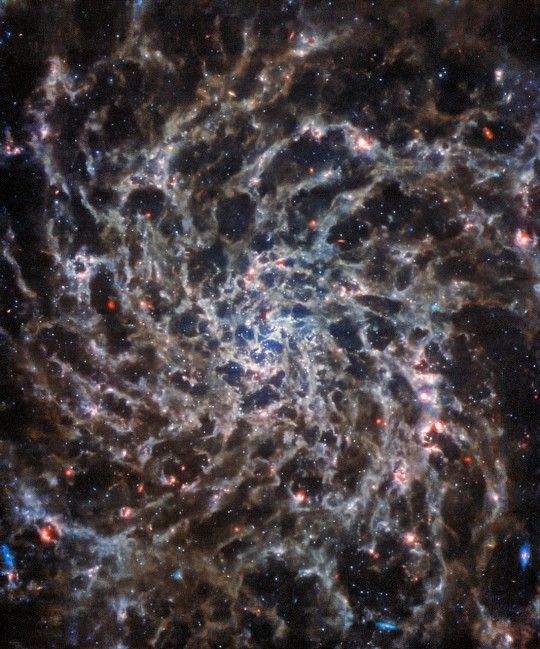
Intricate Infrared Spiral
91 notes
·
View notes
Link
This glittering image from the NASA/ESA Hubble Space Telescope shows the spiral galaxy IC 5332. The galaxy lies about 30 million light-years away in the constellation Sculptor and has an almost face-on orientation to Earth. To understand the term "face-on," it is helpful to visualize a spiral galaxy as an extremely large disk. If the galaxy's orientation makes it appear circular and disk-shaped from our perspective on Earth, then we say that it is "face-on."
0 notes
Text
'S' sta per 'Spirale', 'AB' sta per ... 'Barra debole'
Questa immagine scintillante mostra la galassia a spirale IC 5332, che si trova a circa 30 milioni di anni luce di distanza nella costellazione dello Scultore e ha un orientamento quasi frontale rispetto alla Terra. Per spiegare cosa si intende per “faccia a faccia”, è utile visualizzare una galassia a spirale come un disco (estremamente) grande. Se la galassia è orientata in modo da apparire…

View On WordPress
0 notes
Photo
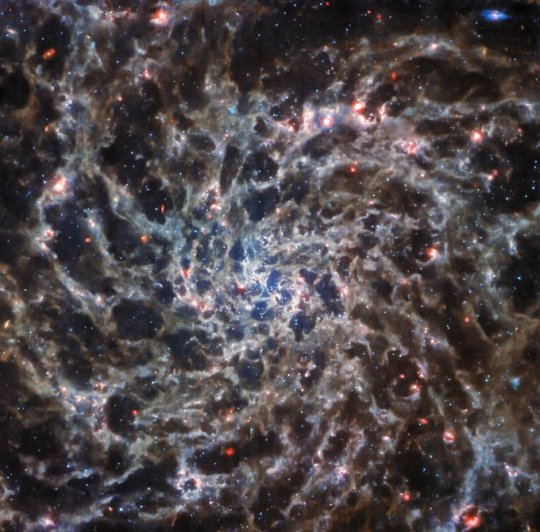
Webb Telescope
This spectacular image features the spiral galaxy IC 5332, shown here in unprecedented detail thanks to observations from the Mid-InfraRed Instrument (MIRI), which is mounted on the NASA/ESA/CSA James Webb Space Telescope. IC 5332 lies over 29 million light-years from Earth, and has a diameter of roughly 66 000 light-years, making it a little larger than the Milky Way. It is notable for being almost perfectly face-on with respect to Earth, allowing us to admire the symmetrical sweep of its spiral arms.
#james webb telescope#webb telescope photos#spiral galaxy IC 5332#nasa#nasa james webb space telescope#nasa picture of the day#space#astronomy#beauty#beautiful#pretty
11 notes
·
View notes
Photo
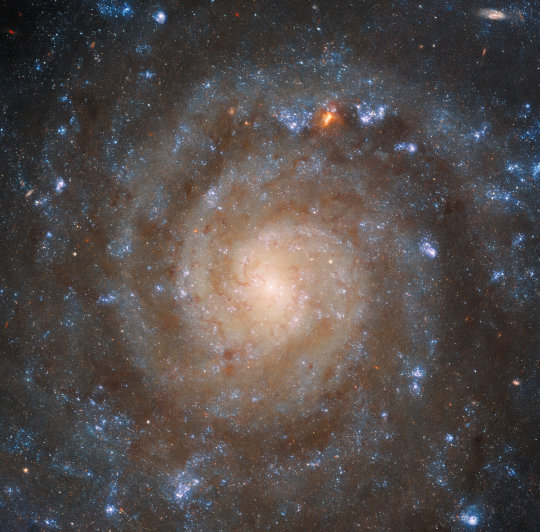

Webb's icy instrument reveals complex structures These spectacular images feature the spiral galaxy IC 5332, taken by the NASA/ESA Hubble Space Telescope (above) and the NASA/ESA/CSA James Webb Space Telescope (below). The images display the powerful capabilities that both world-leading space telescopes provide, especially when combining their data. The Webb image shows the spiral galaxy in unprecedented detail thanks to observations from its Mid-InfraRed Instrument (MIRI). IC 5332 lies over 29 million light-years from Earth, and has a diameter of roughly 66,000 light-years, making it a little larger than the Milky Way. It is notable for being almost perfectly face-on with respect to Earth, allowing us to admire the symmetrical sweep of its spiral arms. MIRI is the only Webb instrument that is sensitive to the mid-infrared region of the electromagnetic spectrum (specifically in the 5 µm–28 µm wavelength range); Webb's other instruments all operate in the near-infrared. Contributed under both ESA and NASA leadership, MIRI is the first instrument that delivers mid-infrared images that are sharp enough to be easily matched to Hubble's view at shorter wavelengths. One of MIRI's most remarkable features is that it operates 33 °C below the rest of the observatory at the frosty temperature of –266 °C. That means that MIRI operates in an environment only 7 °C warmer than absolute zero, which is the lowest possible temperature according to the laws of thermodynamics. MIRI requires this frigid environment in order for its highly specialized detectors to function correctly, and it has a dedicated active cooling system to ensure that its detectors are kept at the correct temperature. It is worth noting just how challenging it is to obtain observations in the mid-infrared region of the electromagnetic spectrum. The mid-infrared is incredibly difficult to observe from Earth as much of it is absorbed by Earth's atmosphere, and heat from Earth's atmosphere further complicates things. Hubble could not observe the mid-infrared region as its mirrors were not cool enough, meaning that infrared radiation from the mirrors themselves would have dominated any attempted observations. The extra effort made to ensure that MIRI's detectors had the freezing environment necessary to operate properly is evident in this stunning image. This extravagantly detailed mid-infrared image is juxtaposed here with a beautiful ultraviolet and visible-light image of the same galaxy, created using data collected by Hubble's Wide Field Camera 3 (WFC3). Some differences are immediately obvious. The Hubble image shows dark regions that seem to separate the spiral arms, whereas the Webb image shows more of a continual tangle of structures that echo the spiral arms' shape. This difference is due to the presence of dusty regions in the galaxy. Ultraviolet and visible light are far more prone to being scattered by interstellar dust than infrared light. Therefore dusty regions can be identified easily in the Hubble image as the darker regions that much of the galaxy's ultraviolet and visible light has not been able to travel through. Those same dusty regions are no longer dark in the Webb image, however, as the mid-infrared light from the galaxy has been able to pass through them. Different stars are visible in the two images, which can be explained because certain stars shine brighter in the ultraviolet, visible and infrared regimes respectively. The images complement one another in a remarkable way, each telling us more about IC 5332's structure and composition.
2 notes
·
View notes